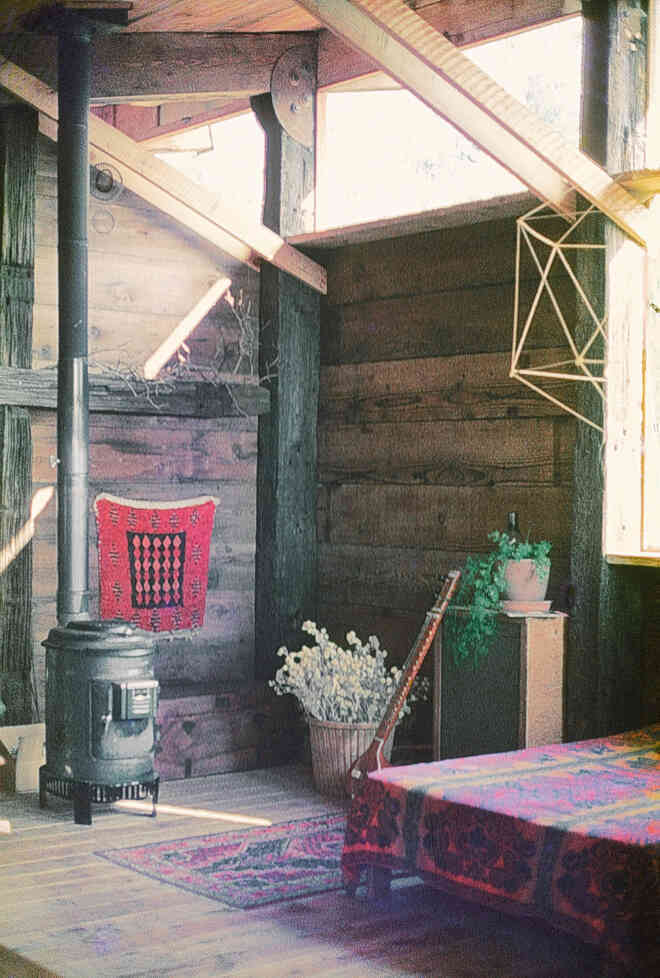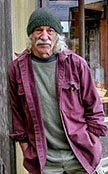
I built this house in 1967–68 at Burns Creek in Big Sur, California (about two miles north of Esalen). The 14 posts were 12-foot-long 6″ by 12″ double-track railroad ties on 8′ centers. The girders, as well as the rafters were 30-foot-long, 2-by-14’s that had been salvaged by Cleveland Wreckers from an old horse stable in San Francisco. Sheathing was lumber from a farm labor camp I tore down in Salinas, and the shakes were split from deadfall trees I found in Palo Colorado Canyon. I used studs in between the posts. For shear panels (diagonal bracing) on one 8-foot-wide section each of the 4 walls, I used ⅝″ plywood nailed 2″ on centers around the edges and 6″ o.c. on the interior studs. I used annular grooved nails, which are way stronger than smooth nails.
Foundation was a grade beam with concrete delivered (40 miles down the coast) from Pacific Grove, on top of which I mixed and poured 14 round piers shaped by cardboard Sonotubes. Steel brackets embedded in the piers held the posts.
 It took me about a year. I did all the carpentry, plumbing, and wiring. It’s a very simple house, a big shed really, and the carpentry is less than exquisite, but it got a roof over our heads. Oh yes, total materials costs were $8,000.
It took me about a year. I did all the carpentry, plumbing, and wiring. It’s a very simple house, a big shed really, and the carpentry is less than exquisite, but it got a roof over our heads. Oh yes, total materials costs were $8,000.
I developed a water supply by building a little dam in a spring 600′ above the house, and running plastic pipe down the hillside. I started some small-scale farming and we had a big garden and I would pick up fish guts in a 50-gallon drum on the Monterey wharf (in our 1960 VW van) on our weekly shopping trips into town.
There were a few things about it that didn’t exactly fit the building codes, so once when the building inspector came, I put on a Jimi Hendrix record loud when I saw him pull up, and he was so rattled that he didn’t notice the non-compliances.
The owners love the house, and I visit once in a while, and camp out next to a studio above the house.
When I decided to leave Big Sur (and embarked on a 5-year period of building geodesic domes), I sold the house to the owners of the land for $11,000.
Item of interest: Barbara Spring, an artist who bought the house from the land owners in the early ’70s, was a friend of the architect Phillip Johnson (post-modern architect known for his Glass House, co-designer (with Mies van der Rohe) of the Seagram Building in NYC, etc.). Johnson was looking for a house to buy in Big Sur and when he came to visit Barbara on a rainy day (with the Ashley Automatic wood stove warming the house), he told her this was the kind of place he would love to find.
 This octagonal wooden structure is one of the beautifully reconstructed buildings at Fort Ross, “…the hub of the southernmost Russian settlements in North America from 1812 to 1841.” See: wikipedia.org/wiki/Fort_Ross,_California
This octagonal wooden structure is one of the beautifully reconstructed buildings at Fort Ross, “…the hub of the southernmost Russian settlements in North America from 1812 to 1841.” See: wikipedia.org/wiki/Fort_Ross,_California










